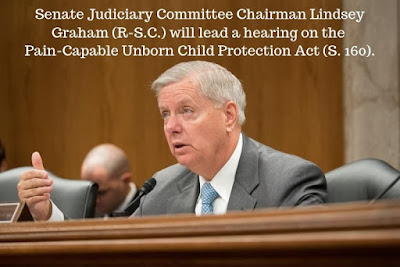On Tuesday Senate Judiciary Committee Chairman Lindsey Graham (R-S.C.) will lead a hearing on the Pain-Capable Unborn Child Protection Act (S. 160).
Since 2010, National Right to Life and its state affiliates have led the effort to protect pain-capable unborn children, starting with enactment of model legislation in Nebraska. Sixteen states have enacted the National Right to Life model legislation, and the law is currently in effect in 15. The legislation has previously passed the U.S. House of Representatives and has garnered a majority of votes in the U.S. Senate.
National Right to Life President Carol Tobias said, “We are proud to stand with our pro-life ally, Sen. Graham, in encouraging the Senate to protect pain-capable unborn children. One-fourth of premature infants now survive when born at this stage – and there is strong evidence that were a child to be aborted at that stage, they would experience great pain, as they are torn limb from limb in late abortions.”
The Pain-Capable Unborn Child Protection Act continues to be one of the right-to-life movement’s top congressional priorities for the 116th Congress. Like the state bills, the proposed federal law would generally extend legal protection to unborn humans beginning at 20 weeks fetal age (22 weeks of pregnancy), based on congressional findings that by that point (and even earlier) the unborn child has the capacity to experience great pain during an abortion.
A February 2019 Marist poll found that 66% of Americans support such legislation.
It is now commonplace to read about evidence that, by 20 weeks fetal age and even earlier, an unborn child responds to many forms of stimuli, including music and the mother’s voice. Claims that the same child is nevertheless insensible to the violence done to her body during an abortion should engender strong skepticism.
Abortions at this stage are performed using a variety of techniques, but most often by a method in which the unborn child’s arms and legs are twisted off by brute manual force, using a long stainless steel clamping tool. A medical illustration of this common method is posted here: www.nrlc.org/abortion/pba/deabortiongraphic
Some of the extensive scientific evidence that unborn children have the capacity to experience pain, at least by 20 weeks, is available online:
www.doctorsonfetalpain.com
www.doctorsonfetalpain.com
www.nrlc.org/uploads/fetalpain/AnandPainReport.pdf
Click here for more from NRL News Today.

